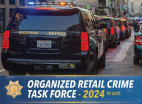Acting on an invitation last fall from Mayor Marsha McLean, California High Speed Rail Authority Chairman of the Board of Directors Dan Richard joined McLean and Councilmember TimBen Boydston, both members of the City’s Ad-Hoc High Speed Transportation sub-committee, for a tour of two proposed rail alignments in the Santa Clarita Valley that are currently being studied, as part of the Palmdale to Burbank section of the project.

California High Speed Rail Chair Dan Richard (center) with Councilman TimBen Boyston and Mayor Marsha McLean.
The California High-Speed Rail Authority is responsible for planning, designing, building and operation of the proposed High Speed Rail Project supported by Governor Brown, planned to run from San Francisco to the Los Angeles basin. The system will eventually extend to Sacramento and San Diego, totaling 800 miles with up to 24 stations.
At this time, the Authority is working on the Draft Environmental documents, having gathered comments from communities that will be affected by the high speed rail project.
“It was very valuable to have the Chair of the Authority here in Santa Clarita, personally spending time with us to learn about our community and how the proposed routes through Santa Clarita could adversely impact area schools, churches, businesses and homes. Mr. Richard was able to see for himself and hear from residents, school officials, realtors and business, how one of the routes, proposed to run above ground, would be especially devastating. It is incumbent upon the Authority to choose the routes that are the least impactful to both people and the environment,” said Mayor McLean.
A third route, to tunnel under the Angeles National Forest, also under study, is the most direct from the Bob Hope Burbank Airport to Palmdale, and preferred by the City of Santa Clarita.
For more information regarding the California High Speed Rail Authority, visit: http://www.hsr.ca.gov/.
Like this:
Like Loading...
Related




 Tweet This
Tweet This Facebook
Facebook Digg This
Digg This Bookmark
Bookmark Stumble
Stumble RSS
RSS





























REAL NAMES ONLY: All posters must use their real individual or business name. This applies equally to Twitter account holders who use a nickname.
14 Comments
Why not just invite Hitler to town as well for a photo opportunity?
This is a colossal waste of time for our local officials. Eventually, the good folks of California will realize that this boondoggle is unaffordable and unsustainable and will be scrapped. This train would cost at least double of what was voted upon, won’t attain nearly the speed and elapsed time projected and will cost far more than a plane ticket to ride to San Francisco. The sooner its dumped the better.
While Santa Clarita may “prefer” the route through the Angeles National Forest, it’s sensitive environment, and the last horse country in Los Angeles, a host of others do NOT!! Santa Clarita wants a station, and HSR has said no. For all the inconvenience, why not give ppl of the LA area some incentive by giving it to them? Otherwise, why would we put up with all the hassle of construction if no one here can use the darned thing to defray the horrible commute?
Sand Canyon, Agua Dulce and Acton are horse country. The people of Sand Canyon, Agua Dulce and Acton absolutely do not want the thing running through their horse country.
Well SCVNews, either do the people living on the proposed Angeles Forest route. The difference is that the E1, E2 & E3 routes were not voted on with the initial proposition. Instead of the people of Santa Clarita pushing our community in front of the train, we should all come together and say NO.
Why don’t you write an article supporting the communities coming together?
Thanks for finally finding us. You’ll be pleased to know we have published something anti-HSR every week for many months … including commentaries calling for communities to band together in opposition. In fact, we don’t recall anyone writing anything in FAVOR of HSR. (We would publish it, if someone wanted to write such a thing, but nobody in his right mind would do so.)
Incidentally. Our state lawmakers have pushed for the abandonment of HSR and the diversion of HSR funds into education programs. Don’t know where you live, but have your representatives done the same?
That is good to hear. I live at the base of the E3 route so am very unhappy at the moment. Considering the local school has a rating of 4 out of 10 I am all for the money being pushed into funding education. Which representatives are you referring to?
Regarding the article, it is sentences like “A third route, to tunnel under the Angeles National Forest, also under study, is … preferred by the City of Santa Clarita.” that leave people feeling like we in the proposed routes are scapegoats and put on the defensive.
Assemblyman Scott Wilk in particular. (You’ll find articles & commentaries from him on this website.) Also yes, if memory serves, the Santa Clarita City Council did endorse a route through the mountains. However, one might note that it was prior to the president designating the area a national monument. One would hope the Obama administration would exert some legalistic pressure to defend the sanctity of the national monument. We happen to agree with you; pitting one community against another would be wrong-headed and destructive. Judging simply from the commentaries that have been submitted to us from the local public, and on our Facebook pages and elsewhere, it is obvious that the vast majority of Santa Clarita Valley residents would prefer for the entire madness to end.
I do agree that we should put more money into education, but not at the expense of the rail project. The money that’s funding the project is from three sources: 1) Prop. 1A, 2) Federal ARRA 2008 stimulus funds, and 3) Cap-‘N’-Trade. Prop. 1A money is bond money, and can only be used for the rail project. Federal ARRA money also can only be used for the rail project, and has to contribute to funding a railway segment with “independent utility.” Finally, cap-n-trade money can only be used for purposes that reduce greenhouse gas emissions. The money going to the railway project cannot be diverted for other uses. I don’t really see what the complaints are about. None of the money going to the project is coming from the CA general fund, minus the service payments from the Prop. 1A bonds.
For one, there is no place to put the thing in Southern California without destroying people’s homes, communities, and/or the environment. High-speed rail is not some sort of a theory or a budget item. It has actual effects on real people.
I guess we’re moving away from the topic of allocation of funds for the project. The argument that the rail project will affect people is a valid one. However, we also have to hold the alternatives to the same scrutiny. Given that California’s population and economy will continue to grow, we can safely assume that people’s travel demands will also increase. That means the our current transportation network’s capacity will be overwhelmed unless major expansion projects are done. There are three options: 1) Do nothing and hope our existing transportation system can handle the extra demand, 2) expand highway and airport capacity, and 3) constructing an intercity high-speed railway system. Doing nothing is really not an option. Highway widening and airport terminal expansion will not only continue people’s dependence on unsustainable travel modes, but they will also destroy “people’s homes, communities, and/or the environment” as you note. The rail project will do the same, but to a lesser extent. It will also cost less than highway widening and airport terminal expansion, and it’s a sustainable mode of travel in terms of energy use, greenhouse gas emissions, and space. One other thing to note is that the rail project is expected to link with the Union Pacific right-of-way that currently hosts Metrolink service. There is room for the project; the challenge is how to get to it.
If you would like a good account of how enormous the effects of automobiles are on society, I suggest Norton’s “Fighting Traffic: The Dawn of the Motor Age in the American City.”
http://www.amazon.com/Fighting-Traffic-American-Inside-Technology/dp/0262516128
Some have suggested running it up the middle of I-5, which makes more sense than destroying private & public property.
I have to note that you’re statement is a bit confusing because going up the I-5 means using public property as well. But anyway, I’ve heard of the I-5 route many times, and it brings many implications. Proponents argue that it would require less taking of private land, and result in a more direct route between the San Francisco Bay Area and Los Angeles Basin. It’s attractive at first glance, but there are reasons to choose the eastern route as well, and it all has to do with connecting the population centers of Fresno, Hanford/Visalia, and Bakersfield directly to the system. This is an issue of 1) good railway route planning, 2) social/economic equity, and 3) fulfilling state and federal mandates. Firstly, if you want to design a good railway line, you need to make sure that it connects population centers throughout its entire length on a relatively direct line. Walker points this out on his Human Transit blog, and calls the concept “Be on the way.”
http://www.humantransit.org/2009/04/be-on-the-way.html
By connecting to Fresno (metro area pop. over 1 million) and Bakersfield (metro area pop. over 300 thousand), you maximize the number of potential riders and, hence, overall success of the system.
Secondly, its a matter of providing the San Joaquin Valley a chance to a more prosperous economic future. The San Joaquin Valley has historically and habitually suffered from higher unemployment rates, higher poverty rates, lower educational attainment rates, and less economic diversity compared to the rest of California. Construction of the system obviously provides a short-term economic stimulus for the Valley by providing income for the construction workers. Once the rail system is up and operating, it makes the San Joaquin Valley within a commuting distance (in terms of travel time) to the SF Bay Area and LA Basin. There is a good chance that people and businesses from wealthier areas in the state will be attracted to settle around the station areas because of lower land values. People with disposable income means more spending, and that spending will benefit businesses in Fresno, Hanford/Visalia, and Bakersfield. I don’t know about you, but personally if we need to make large, statewide transportation investments, I think they should benefit the majority of Californians, and not just those that live in the SF Bay Area or LA Basin.
Thirdly, in Prop. 1A, the state law that authorizes the sale of bonds to fund the project, it is specifically written that the railway system must connect Fresno and Bakersfield. See under Article 2 for the specific corridors outlined by Prop. 1A:
http://www.leginfo.ca.gov/pub/07-08/bill/asm/ab_3001-3050/ab_3034_bill_20080826_chaptered.html
Also, as I stated earlier, federal ARRA 2008 stimulus funds can only help construct segments in the Central Valley that have “independent utility.” That means that even if it isn’t used for high-speed train service, it can still be used for Amtrak service that runs between Fresno Bakersfield. The I-5 route is riskier because once you start, you have to connect all the way to the SF Bay Area and LA Basin for the segment to connect to population centers and have any utility whatsoever, versus building between Fresno and Bakersfield, which is a shorter distance and already connects to major population centers. Those are just my thoughts anyway…